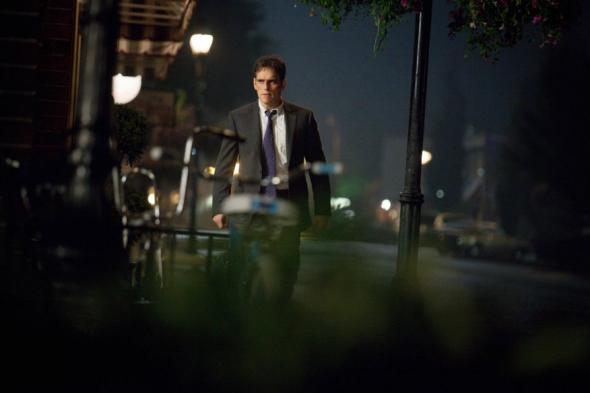In the opening scenes of Wayward Pines, which premieres Thursday on Fox, a man comes to consciousness in what appears to be the forest, clueless about where he is or how the hell he got there. From there, the confusion never lets up: In the five episodes Fox released to critics, the questions—and the creepy qualities of the town where Ethan Burke (Matt Dillon) finds himself trapped—become more plentiful and increasingly bizarre; the only thing missing is the Statue of Liberty poking out of the sand.
Before he woke up in the woods, Burke was a Secret Service agent on a mission to locate two missing colleagues, but separated from his possessions and unable to make contact with anyone outside the confines of Wayward Pines, Idaho, he’s just a disheveled, rebellious dude in a town full of neat, obedient drones. Fortunately for Burke, early in his stay, a friendly barkeep (Juliette Lewis) passes him a clue when she hands him his bill: “There are no crickets in Wayward Pines,” she writes. It’s true, but you wonder why she focused on the ersatz wildlife when the town is ruled with an iron fist by unseen but murderous overlords.
Burke quickly learns that Wayward Pines is, let’s say, a closed community; that dead bodies are being stored in a ramshackle property that is apparently exempt from rules that govern the rest of the town; and that his wife and son aren’t safe at home in Seattle as he thought. And that’s just the start of his discoveries. Every episode is thick with new developments and deductions; the problem is making sense of them. Some of the residents—including Burke’s ex-partner (in more ways than one) Kate Hewson (Carla Gugino), who believes she’s been in Wayward Pines for years, despite his having seen her in Seattle just a few weeks before—act like prisoners, reluctantly following the rules in hopes of survival. Others, like the sinister Nurse Pam (Melissa Leo) and bullying Sheriff Pope (Terrence Howard), are true believers, ready to kill to keep the community safe.
The bad guys are almost comically evil. Howard is repeatedly directed to eat ice cream malevolently—at one point, he warbles the lines, “Rum raisin. Hmm!” while Burke is describing a decomposing corpse. The more Leo’s Nurse Pam tries to seem ditzy and deferential, the more she reveals herself to be a tyrannical bully. It’s hard to figure them out: At times they seem all-powerful, at others they’re weak and easily thwarted. In the first episode, for example, Pam and the creepy Dr. Jenkins, who appear to be the only medical personnel in Wayward Pines’ vast hospital, threaten to perform brain surgery on Agent Burke. The possibility is terrifying and should’ve been drawn out; instead he manages to discharge himself without even getting his head shaved.
Although it is based on a series of books by Blake Crouch, Wayward Pines feels like a massive TV mashup. You don’t need a particularly sensitive palate to identify the ingredients: a few pounds of Twin Peaks, a heaping helping of Under the Dome, several jiggers of The Prisoner, a few teaspoons of The Shining, and a big dollop of Lost. Production design from Northern Exposure and the slogan from Black Flag Roach Motel. There are even a few surprise ingredients—a bit of Homeland’s backstory and an existential threat borrowed from Game of Thrones.
This is M. Night Shyamalan’s first television project—he’s an executive producer and directed the first episode—so perhaps we should be primed for surprises, but the biggest shock for me was how little I cared about the show’s lack of originality. In some ways, it’s a perfect summer show—just complicated enough to hold viewers’ attention without raising their temperature or heart rate. Wayward Pines is being released in 125 markets, but it’s perfect for America: While the rest of the developed world enjoys a long summer vacation, we’re chained to our desks the way Agent Burke is trapped in his Idaho hell hole.
